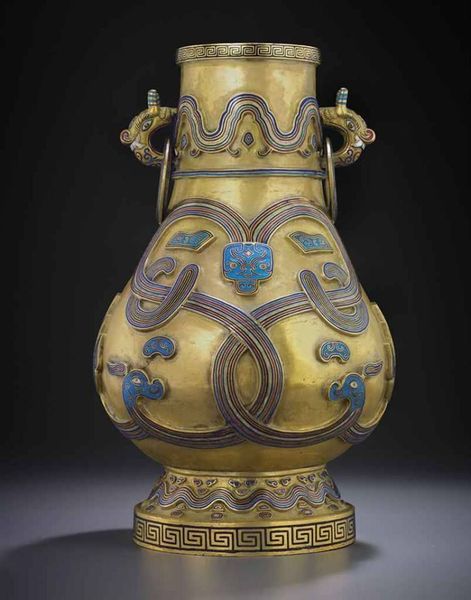A very rare Imperial Champleve and Gilt-Bronze Archaistic Vase, Hu. Qianlong period (1736-1795)
A very rare Imperial Champleve and Gilt-Bronze Archaistic Vase, Hu. Qianlong period (1736-1795). Photo Christies Image Ltd 2013
The baluster body of the hu-shaped vase is decorated on both sides in champlevé enamels of deep blue, turquoise, orange, black, white and green with interlaced scrollwork in relief issuing from stylised taotiemasks and terminating in dragon-heads, linked by mythical beast masks, all reserved on the gilt-bronze ground. The tapering neck is adorned by an undulating band filled with formal ring and hook motifs, flanked by a pair of loop handles. 15 1/2 in. (39.3 cm.) high. Estimate $323,567 - $452,994
Provenance: Gerard Hawthorn, London, 2005
Sold at Bonhams London, 6 November 2006, lot 190
Literature: Reverence and Perfection: Magnificent Imperial Cloisonné Enamels from a Private European Collection, Hong Kong, 2013, no. 17
 Notes: The present vase is exceedingly rare both in terms of its motifs and the technique used, and no other example appears to have been published to date. One close comparison is known, a champlevé hu vase of very similar shape and design in the collection of the Beijing Palace Museum (illustrated in Compendium of Collections in the Palace Museum - Enamels (3) - Cloisonne in the Qing Dynasty (1644-1911), Beijing, 2011, pl. 85). The motifs on the Palace Museum vase are almost identical to those on the current vase, such as thetaotie masks, dragon-heads and scrollwork between unduating bands, but are reserved on a turquoise ground densely adorned with further abstract motifs, instead of a plain gilt-bronze ground as on the current vase.
Notes: The present vase is exceedingly rare both in terms of its motifs and the technique used, and no other example appears to have been published to date. One close comparison is known, a champlevé hu vase of very similar shape and design in the collection of the Beijing Palace Museum (illustrated in Compendium of Collections in the Palace Museum - Enamels (3) - Cloisonne in the Qing Dynasty (1644-1911), Beijing, 2011, pl. 85). The motifs on the Palace Museum vase are almost identical to those on the current vase, such as thetaotie masks, dragon-heads and scrollwork between unduating bands, but are reserved on a turquoise ground densely adorned with further abstract motifs, instead of a plain gilt-bronze ground as on the current vase. The unusual archaistic design on both vases was largely inspired by archaic bronze vessels from the Zhou Dynasty. A line drawing of a closely related bronze hu, dating to the Zhou dynasty, was published in theXiqing Gujian, 'Inspection of Antiques', a catalogue of early period bronzes collected in the imperial palace and published under the auspices of the Qianlong Emperor. Despite being largely similar, the motifs on the bronze prototype are notably more angular, while the Qing adaptations are executed with an added degree of fluidity and colourful touch, reflecting the Qianlong Emperor's archaistic pursuit accompanied by a penchant for the splendid and elaborate.
The unusual archaistic design on both vases was largely inspired by archaic bronze vessels from the Zhou Dynasty. A line drawing of a closely related bronze hu, dating to the Zhou dynasty, was published in theXiqing Gujian, 'Inspection of Antiques', a catalogue of early period bronzes collected in the imperial palace and published under the auspices of the Qianlong Emperor. Despite being largely similar, the motifs on the bronze prototype are notably more angular, while the Qing adaptations are executed with an added degree of fluidity and colourful touch, reflecting the Qianlong Emperor's archaistic pursuit accompanied by a penchant for the splendid and elaborate. Similar designs are also applied on contemporaneous imperial porcelains. Compare for example to a Yongzheng-marked pale celadon-glazed hu vase of the same shape with similar handles, relief-decorated with an undulating band above abstract scrolling dragons, sold at Christie's Hong Kong, 27 May 2008, lot 1590.
Similar designs are also applied on contemporaneous imperial porcelains. Compare for example to a Yongzheng-marked pale celadon-glazed hu vase of the same shape with similar handles, relief-decorated with an undulating band above abstract scrolling dragons, sold at Christie's Hong Kong, 27 May 2008, lot 1590.
Christies. REVERENCE AND PERFECTION - MAGNIFICENT IMPERIAL CLOISONNE ENAMELS FROM A PRIVATE EUROPEAN COLLECTION. 29 May 2013. Convention Hall.

/https%3A%2F%2Fprofilepics.canalblog.com%2Fprofilepics%2F1%2F0%2F100183.jpg)
/https%3A%2F%2Fstorage.canalblog.com%2F03%2F02%2F119589%2F96711876_o.jpg)
/https%3A%2F%2Fstorage.canalblog.com%2F11%2F31%2F119589%2F94773502_o.jpg)
/https%3A%2F%2Fstorage.canalblog.com%2F20%2F83%2F119589%2F94772815_o.jpg)
/https%3A%2F%2Fstorage.canalblog.com%2F26%2F72%2F119589%2F75604929_o.jpg)
/https%3A%2F%2Fstorage.canalblog.com%2F59%2F60%2F119589%2F26458628_o.jpg)



/image%2F1371349%2F20240425%2Fob_e64568_440367995-1657703268333019-41468471616.jpg)
/http%3A%2F%2Fstorage.canalblog.com%2F63%2F62%2F119589%2F129821675_o.jpg)
/http%3A%2F%2Fstorage.canalblog.com%2F43%2F82%2F119589%2F129801198_o.png)
/http%3A%2F%2Fstorage.canalblog.com%2F40%2F90%2F119589%2F129784381_o.jpg)